Configuring the Emailer Suite
Before using any of the Emailer suite of products (Document Emailer, Remittance Emailer, or Statement Emailer) you need to:
-
Ensure that applicable users have access to Reporting Services. This is needed because the documents that are emailed are generated using Reporting Services. For more information, refer to Provide a User Access to Reporting Services.
-
Applying Report Settings - specify the location of the report server and where copies of any reports produced should be saved.
-
Configuring Reports - select the report template to be used for the document being emailed for each module in the Emailer Suite.
-
Configuring Email Settings - configure SMTP settings to connect the Emailer Suite module to the SMTP server.
Logging in
Log into each module that you need to set up (based on the modules that you use).
Logging into the Document Emailer (IRIS Financials version 7 and above)
Logging into the Remittance Emailer (IRIS Financials version 7 and above)
Logging into Remittance Emailer
Logging into the Statement Emailer (IRIS Financials version 7 and above)
Logging into Statement Emailer
Applying Report Settings
For each module in the Emailer Suite, you need to specify the location of the report server (or SQL server if you do not have a dedicated report server). This is required to identify the report templates that are used to generate applicable documents.
When documents are created, they can be saved to a specified location where they can be printed or used as required. This location also needs to be specified.
- elect the Settings icon on the toolbar.

-
The Settings dialog is displayed consisting of three tabs. Use Global Report Settings should be selected if everyone in your organisation is using the same email template and one central mailbox. If you are unsure, please do not select this.
-
The Reportserver URL is the location of your report server. You can get this from another user within your establishment/organisation or from your IT department. For PS Cloud customers, the URL is typically http://[your PS Cloud account code]/reportserver. If you do not have a dedicated report server, this should be the location of your SQL server.
-
The Reports export location field determines where the PDF copies for reports and documents are saved. Select Drill (...), then select the required location.
-
Select Save once all the settings have been applied.
Configuring Reports
In order for reports and documents to be successfully produced, the applicable module in the Emailer Suite must have an applicable report template attached. This defines the content and layout of the report/document being emailed. The process is the same for each module, except where specified.
-
Select the Configure Reports icon on the toolbar
.
-
The Reports Configuration dialog is displayed. For Document Emailer, you need to apply the configuration settings for both Accounting and Purchasing mode, together with the specific document being emailed. This is achieved by selecting the required options from both the Mode and Doctype drop-down lists.
Selecting the Report Template
The first part of the report configuration is to choose the report template to be used to create the document being emailed. This needs to be done for each module in the Emailer Suite.
-
Select Drill(...) in Location.
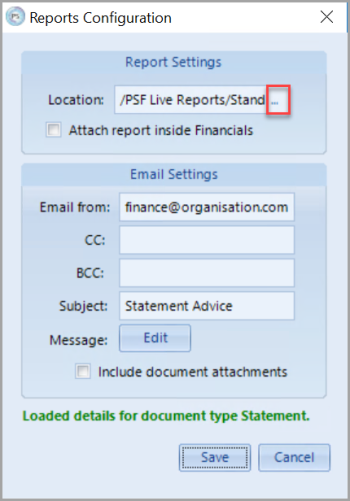
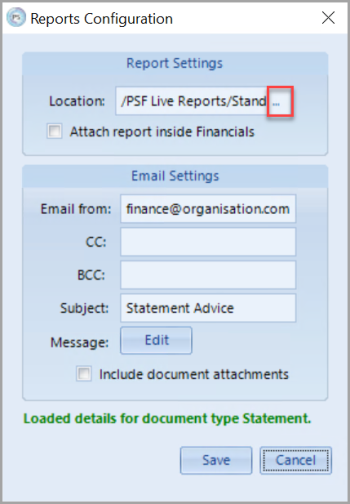
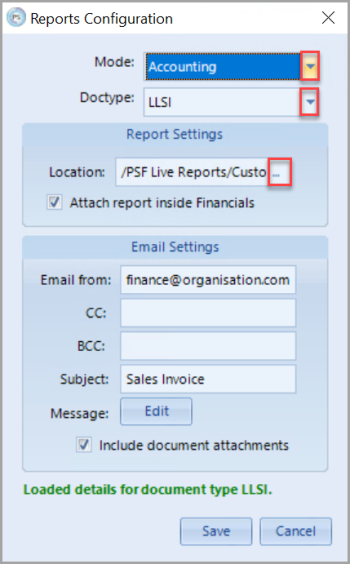
Statement Emailer Remittance Emailer Document Emailer - The Report Browser window is displayed. At the top of the window, the default folder for standard reports is displayed. If the required report template is stored elsewhere, select the drop-down arrow to select another folder. For example, select the folder /PSF Live Reports/Standard Reports, then the Sales Statement icon in the Statement Emailer module.

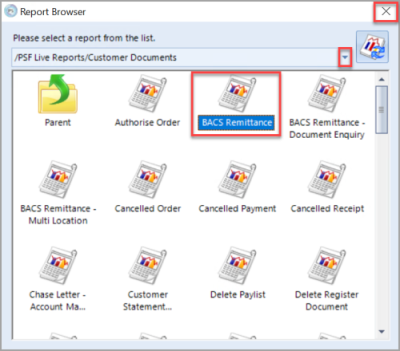
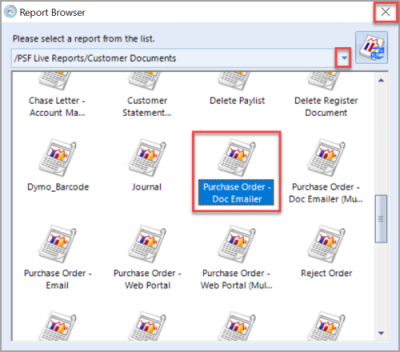
Statement Emailer Remittance Emailer Document Emailer - Once the required report has been selected, select the X to close the window and return to the Reports Configuration dialog.
- It is possible to save the document/report produced for the email as a PDF attachment to the applicable document in IRIS Financials. This is achieved by selecting Attach report inside Financials.
Configuring Email Settings
From the Reports Configuration dialog, you can also configure the settings for emails. This needs to be done for all the modules within the Emailer Suite that are being used.
-
Enter the email address that the emails are being sent from in Email from - this is the email address that any replies are sent to. Add any CC or BCC emails, if required.
- Enter the subject of the email in Subject.
- If you want to include any files attached to the document that is being emailed, select Include document attachments. For example, if you are emailing a purchase order that contains a quote, this is also be included in the email.
-
You can also enter the text of the email to be sent. Select Edit. The Message Editor dialog is displayed.
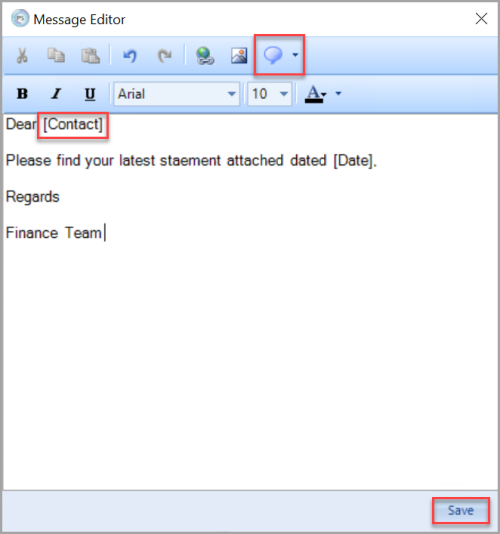
- Enter the content of the email, formatting as required using the icons on the toolbar. You can add tokens that are replaced with the value stored in IRIS Financials (similar to mailmerge). This can be useful for making the email more personal (by adding a Contact) or using specific values such as Date (as shown in the previous graphic). This is achieved by selecting the required token from the Token drop-down list.
- Once you are happy with the content, select Save.
- Select Save on the Reports Configuration dialog to save the changes you have made.
Applying SMTP Settings (non PS Cloud customers only)
In order for emails to be sent correctly, you need to set up the SMTP settings on each user's machine. These settings link the Emailer Suite module to your email server.
-
Select the Smtp Settings icon on the Emailer Suite module. In the following graphic, the Statement Emailer is displayed.

The most efficient way to complete the SMTP settings is to ask another user to take a screenshot of their Smtp Settings dialog and use these to complete your configuration.
-
The Smtp Settings dialog is displayed with all available fields greyed out. Select New.
-
Fields in the right-hand panel are then enabled. Overwrite the word NEW with a name for this SMTP configuration in Name. This enables you to identify the configuration in the future.
-
In Mail Host, enter the email hosting server name and server port in Port. This information can be copied from another user, or obtained from your IT department.
-
If your SMTP server uses SSL or TLS, select Use SSL/TLS.
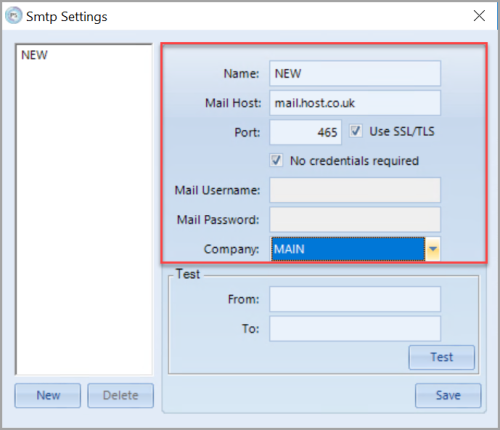
-
If your SMTP server requires a user name and password, enter these in Mail Username and Mail Password. Otherwise, select No credentials required.
-
You can add different SMTP settings for different companies in your PS Financials system. If the current SMTP settings are only applicable for one company, select the applicable option from Company drop-down list.
-
When you have entered all the applicable settings, you can test the connection to the SMTP server by typing an email address in From and To and selecting Test.
-
When you have finished, select Save.